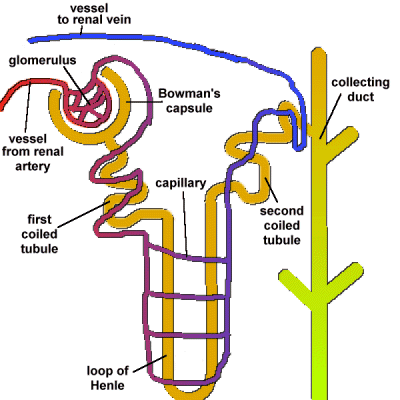The Nephron
The kidney tubule or nephron is the working unit of the kidney. There are one million of these in each kidney. Branches of the renal artery form tiny capillaries. Along the length of each capillary is a knot called a glomerulus.

The capillary entering the glomerulus is wider than the capillary leaving it. This makes the pressure inside the glomerulus high. This forces some of the blood plasma out of the vessels. Large objects like proteins and blood cells are too big to leak out. The smaller particles like water, salts, urea, glucose & amino acids leak out of the capillary and are termed the glomerular filtrate. This filtrate is collected in a cup like structure called the Bowman's capsule. This is the first part of the kidney tubule and leads into the first coiled tubule.
The cells lining the first coiled tubule actively reabsorb the nutrients and other chemicals the body needs, leaving behind the unwanted urea, salts and some water. The cells are adapted for this. They have lots of mitochondria for active transport and they have microvilli (tiny finger-like folds of the cell membrane) which increase the surface area for absorption. By the time the filtrate reaches the end of this coiled tubule, all the important chemicals (i.e. glucose, amino acids & vitamins etc) have been reabsorbed along with 99% of the water. What remains in the filtrate is the unwanted salts, urea and water, along with any other chemical the body does not need (like alcohol, drugs etc).
The rest of the kidney tubule (the loop of Henle, the second coiled tubule and the collecting duct) is designed to reabsorb some of the remaining water as necessary. The remaining fluid, called urine, passes down the collecting duct to the pelvis of the kidney and then onto the bladder (via the ureter) where it is temporarily stored.
The blood leaving the kidney differs from the blood entering the kidney in a number of ways.
| Blood entering the kidney | Blood leaving the kidney |
|---|---|
| High in urea | No urea |
| High in oxygen | Low in oxygen (due to respiration) |
| No carbon dioxide | High in carbon dioxide (due to respiration) |
| Glucose levels high | Glucose present but lowering in concentration. (due to respiration) |
